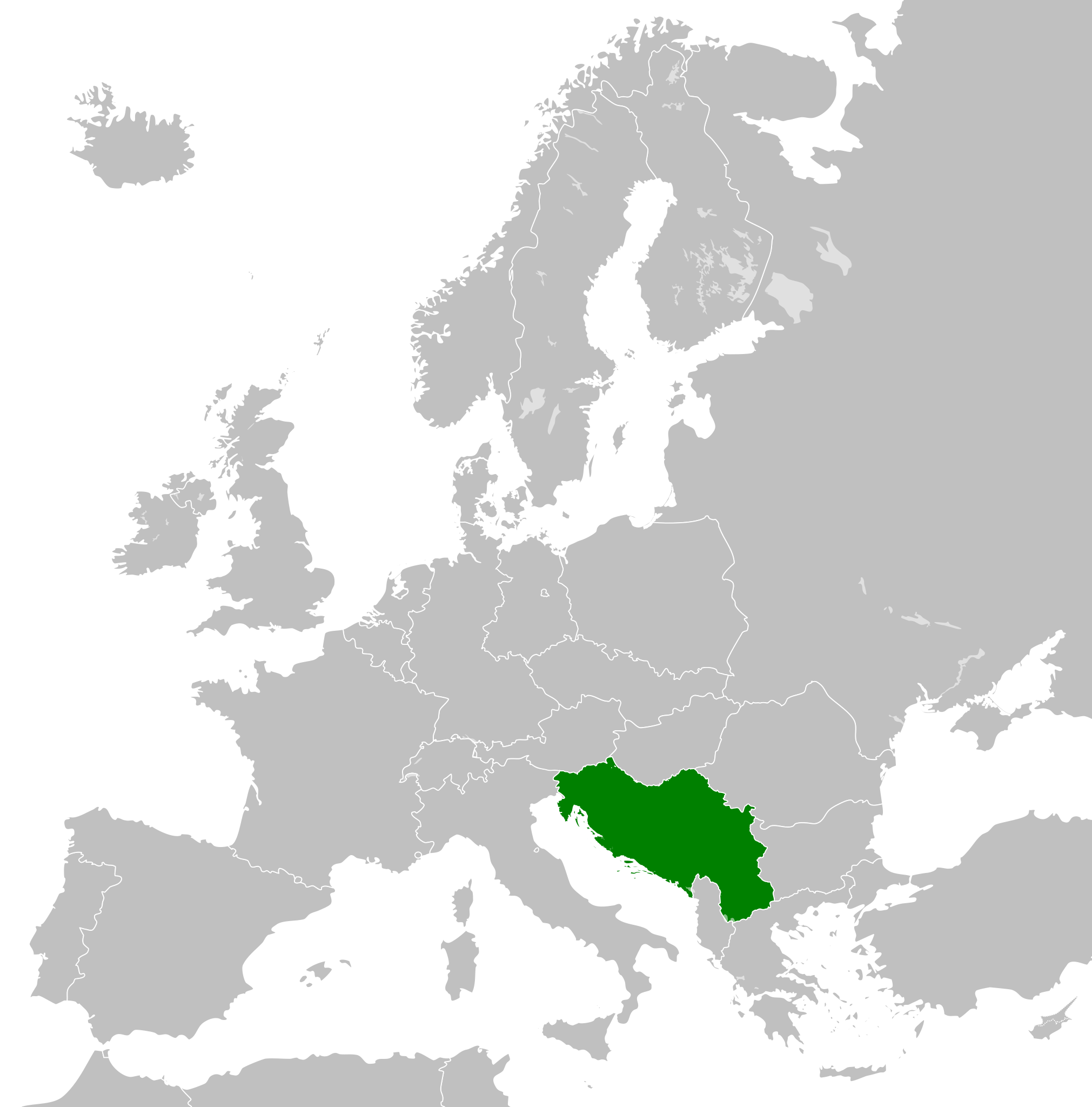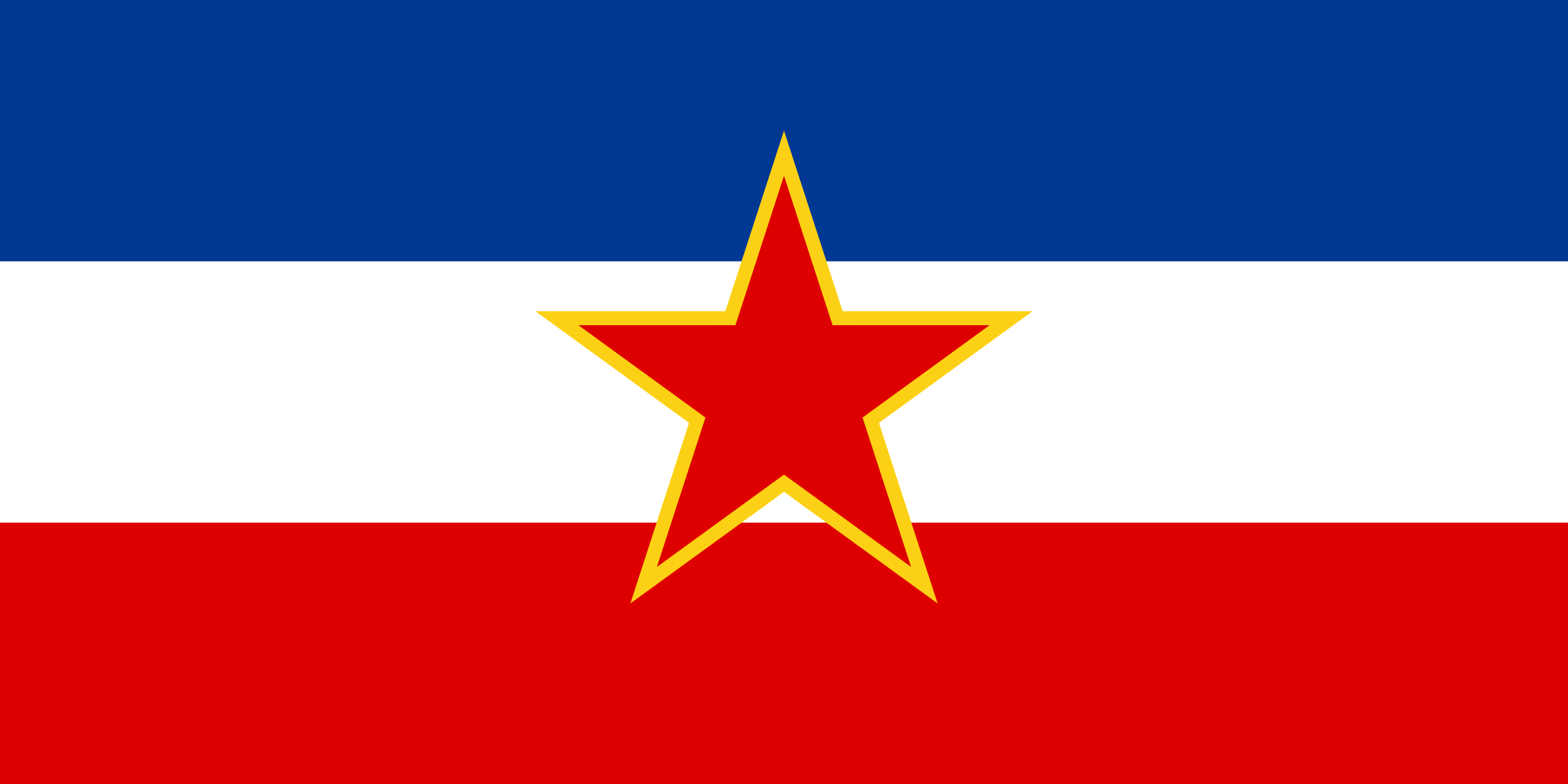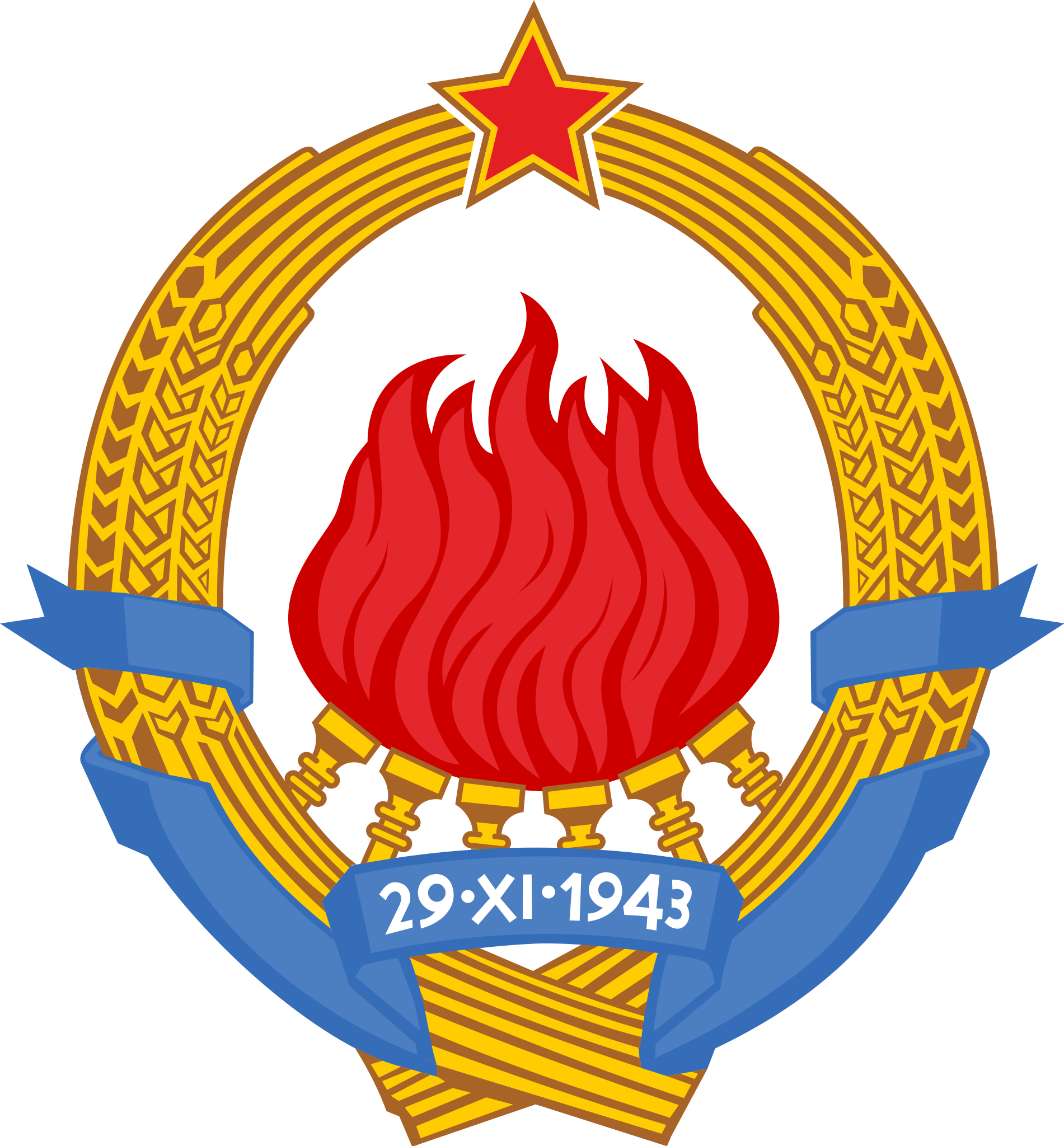Socialist Federal Republic of Yugoslavia (1945–1992): Difference between revisions
More languages
More actions
Tag: Visual edit |
(Added to first paragraph) Tag: Visual edit |
||
| Line 1: | Line 1: | ||
<blockquote>''"Yugoslavia" redirects here. For the kingdom, see [[Kingdom of Yugoslavia (1918–1941)]]. For its successor rump state, see [[Federal Republic of Yugoslavia (1992–2006)]].''</blockquote>{{Infobox country|name=Socialist Federal Republic of Yugoslavia|national_languages=Macedonian<br>Serbo-Croatian<br>Slovene|capital=[[Belgrade]]|population_estimate_year=2021|population_estimate=23,229,846|area_km2=255,804|government_type=One-party parliamentary republic|mode_of_production=[[Socialism]]|image_map_size=200|native_name=Социјалистичка Федеративна Република Југославија<br>Socialistična Federativna Republika Jugoslavija|year_end=1992|year_start=1945|image_map=Yugoslavia map.png|image_symbol=Yugoslav COA.png|symbol_type=Emblem|image_flag=Yugoslav flag.png|largest_city=[[Belgrade]]}} | <blockquote>''"Yugoslavia" redirects here. For the kingdom, see [[Kingdom of Yugoslavia (1918–1941)]]. For its successor rump state, see [[Federal Republic of Yugoslavia (1992–2006)]].''</blockquote>{{Infobox country|name=Socialist Federal Republic of Yugoslavia|national_languages=Macedonian<br>Serbo-Croatian<br>Slovene|capital=[[Belgrade]]|population_estimate_year=2021|population_estimate=23,229,846|area_km2=255,804|government_type=One-party parliamentary republic|mode_of_production=[[Socialism]]|image_map_size=200|native_name=Социјалистичка Федеративна Република Југославија<br>Socialistična Federativna Republika Jugoslavija|year_end=1992|year_start=1945|image_map=Yugoslavia map.png|image_symbol=Yugoslav COA.png|symbol_type=Emblem|image_flag=Yugoslav flag.png|largest_city=[[Belgrade]]}} | ||
'''Yugoslavia''', officially the '''Socialist Federal Republic of Yugoslavia''', was a [[Non-Aligned Movement|non-aligned]]<ref>{{Citation|author= | '''Yugoslavia''', officially the '''Socialist Federal Republic of Yugoslavia''', was a [[Non-Aligned Movement|non-aligned]] [[socialist state]] in the [[Balkans]]. It was a multiethnic federation that consisted of 28 [[Nation|nationalities]].<ref name=":03">{{Citation|author=[[Michael Parenti]]|year=2000|title=To Kill a Nation|chapter=Hypocritical Humanitarianism|page=13|pdf=https://leftychan.net/edu/src/1614706295182-3.pdf|publisher=Verso}}</ref> The [[United States of America|USA]] tolerated Yugoslavia's existence during the [[Cold War]] because it served as a buffer against the [[Warsaw Pact]], but the United States turned against it soon after.<ref name=":2">{{Citation|author=[[Michael Parenti]]|year=2000|title=To Kill a Nation|page=17–18|chapter=Third Worldization|publisher=Verso|pdf=https://leftychan.net/edu/src/1614706295182-3.pdf}}</ref> | ||
==History== | ==History== | ||
| Line 22: | Line 22: | ||
After Tito's death in 1980, the [[International Monetary Fund|IMF]] imposed an austerity program on Yugoslavia, increasing unemployment. By 1991, unemployment had reached 20% and annual inflation was about 200%.<ref name=":1" /> | After Tito's death in 1980, the [[International Monetary Fund|IMF]] imposed an austerity program on Yugoslavia, increasing unemployment. By 1991, unemployment had reached 20% and annual inflation was about 200%.<ref name=":1" /> | ||
Croatia and Slovenia broke away from Yugoslavia in 1991 with support from the | Croatia and Slovenia broke away from Yugoslavia in 1991 with support from the United States and [[Federal Republic of Germany|Germany]]. [[Socialist Republic of Bosnia and Herzegovina (1943–1992)|Bosnia and Herzegovina]] broke away in April 1992, reducing Yugoslavia to only [[Federal Republic of Yugoslavia (1992–2006)|Serbia and Montenegro]].<ref>{{Web citation|author=Victor Penn|newspaper=[[Liberation News]]|title=Yugoslavia: Ten years after the NATO massacre|date=2009-03-31|url=https://www.liberationnews.org/09-03-31-yugoslavia-ten-years-after-nato-html/|archive-url=https://web.archive.org/web/20220506081614/https://www.liberationnews.org/09-03-31-yugoslavia-ten-years-after-nato-html/|archive-date=2022-05-06|retrieved=2022-09-09}}</ref> | ||
==Economy== | ==Economy== | ||
From 1939 to 1975, income tripled and industrial development increased by nine times.<ref name=":1" /> Between 1952 and 1979, Yugoslavia's economy grew by almost 400%. The economy began to stagnate after Tito's death.<ref name=":0">{{Citation|author=Latinka Perović, et al.|year=2017|title=Yugoslavia from a Historical Perspective|pdf=https://web.archive.org/web/20200113132255/http://www.yuhistorija.com/doc/yugoslavia%20from%20a%20historical%20perspective.pdf|city=Belgrade|publisher=Helsinki Committee for Human Rights in Serbia}}</ref> The republics of Slovenia and Croatia and the autonomous province of [[Socialist Autonomous Province of Vojvodina (1945–1990)|Vojvodina]] were the most economically developed and had the highest per capita income. The southern areas of Montenegro, [[Socialist Republic of Macedonia (1944–1991)|Macedonia]], and [[Socialist Autonomous Province of Kosovo (1945–1990)|Kosovo]] were the least developed, although the government subsidized more development in these regions.<ref name=":1" /> | From 1939 to 1975, income tripled and industrial development increased by nine times.<ref name=":1" /> Between 1952 and 1979, Yugoslavia's economy grew by almost 400%. The economy began to stagnate after Tito's death.<ref name=":0">{{Citation|author=Latinka Perović, et al.|year=2017|title=Yugoslavia from a Historical Perspective|pdf=https://web.archive.org/web/20200113132255/http://www.yuhistorija.com/doc/yugoslavia%20from%20a%20historical%20perspective.pdf|city=Belgrade|publisher=Helsinki Committee for Human Rights in Serbia}}</ref> The republics of Slovenia and Croatia and the autonomous province of [[Socialist Autonomous Province of Vojvodina (1945–1990)|Vojvodina]] were the most economically developed and had the highest per capita income. The southern areas of Montenegro, [[Socialist Republic of Macedonia (1944–1991)|Macedonia]], and [[Socialist Autonomous Province of Kosovo (1945–1990)|Kosovo]] were the least developed, although the government subsidized more development in these regions.<ref name=":1" /> | ||
Large and medium-scale industry, transport, and [[Bank|banking]] were nationalized in Yugoslavia.'''<ref name=":02">{{Citation|year=1954|title=Political Economy|chapter=The Economic System of the People's Democracies in Europe|chapter-url=https://www.marxists.org/subject/economy/authors/pe/pe-ch41.htm|section=The Character of the People's Democratic Revolution|mia=https://www.marxists.org/subject/economy/authors/pe/index.htm}}</ref>''' | Large and medium-scale industry, transport, and [[Bank|banking]] were nationalized in Yugoslavia.'''<ref name=":02">{{Citation|year=1954|title=Political Economy|chapter=The Economic System of the People's Democracies in Europe|chapter-url=https://www.marxists.org/subject/economy/authors/pe/pe-ch41.htm|section=The Character of the People's Democratic Revolution|mia=https://www.marxists.org/subject/economy/authors/pe/index.htm}}</ref>''' 60% of [[Proletariat|workers]] remained in the public sector as late as 1990. Citizens had a guaranteed right to an income and a month of paid vacation.<ref name=":2" /> | ||
==Living standards== | ==Living standards== | ||
===Healthcare=== | ===Healthcare=== | ||
From 1939 to 1978, the number of hospital beds per 10,000 people increased from 19 to 60 and the number of physicians increased by 400%, while infant mortality decreased by 75%. Diphtheria, malaria, and typhus were also eliminated. 82% of the population was covered by health insurance.<ref>{{Citation|author=Muhamed Saric, Victor R. Godwin|title=The Once and Future Health System in the Former Yugoslavia: Myths and Realities|title-url=https://web.archive.org/web/20060917174823/http://www.nyu.edu/projects/rodwin/future.html|publisher=New York University}}</ref> From 1948 to 1981, the life expectancy increased from 53 years for women and 48.6 years for men to 73.2 and 67.7 years, respectively. By 1966, Yugoslavia's mortality rate decreased to 8.1 deaths per thousand people, which was lower than [[French Republic|France]] or the [[United Kingdom of Great Britain and Northern Ireland|UK]] at the time.<ref name=":0" /> | Yugoslavia had [[Universal healthcare|free medical care]].<ref name=":2" /> From 1939 to 1978, the number of hospital beds per 10,000 people increased from 19 to 60 and the number of physicians increased by 400%, while infant mortality decreased by 75%. Diphtheria, malaria, and typhus were also eliminated. 82% of the population was covered by health insurance.<ref>{{Citation|author=Muhamed Saric, Victor R. Godwin|title=The Once and Future Health System in the Former Yugoslavia: Myths and Realities|title-url=https://web.archive.org/web/20060917174823/http://www.nyu.edu/projects/rodwin/future.html|publisher=New York University}}</ref> From 1948 to 1981, the life expectancy increased from 53 years for women and 48.6 years for men to 73.2 and 67.7 years, respectively. By 1966, Yugoslavia's mortality rate decreased to 8.1 deaths per thousand people, which was lower than [[French Republic|France]] or the [[United Kingdom of Great Britain and Northern Ireland|UK]] at the time.<ref name=":0" /> | ||
===Housing=== | ===Housing=== | ||
Revision as of 23:06, 3 June 2023
"Yugoslavia" redirects here. For the kingdom, see Kingdom of Yugoslavia (1918–1941). For its successor rump state, see Federal Republic of Yugoslavia (1992–2006).
| Socialist Federal Republic of Yugoslavia Социјалистичка Федеративна Република Југославија Socialistična Federativna Republika Jugoslavija | |
|---|---|
| 1945–1992 | |
 | |
| Capital and largest city | Belgrade |
| Recognised national languages | Macedonian Serbo-Croatian Slovene |
| Dominant mode of production | Socialism |
| Government | One-party parliamentary republic |
| History | |
• Established | 1945 |
• Dissolution | 1992 |
| Area | |
• Total | 255,804 km² |
| Population | |
• 2021 estimate | 23,229,846 |
Yugoslavia, officially the Socialist Federal Republic of Yugoslavia, was a non-aligned socialist state in the Balkans. It was a multiethnic federation that consisted of 28 nationalities.[1] The USA tolerated Yugoslavia's existence during the Cold War because it served as a buffer against the Warsaw Pact, but the United States turned against it soon after.[2]
History
Second World War
In April 1941, Yugoslavia was invaded by fascist armies from Germany, Italy, Hungary, Romania, and Bulgaria. The country was split into German and Italian zones of control. A partisan resistance movement began in the summer of 1941 and grew to an army of 800,000 by 1944, when the partisans and the Soviet Red Army liberated Belgrade.[3] The party grew from 12,000 at the start of the war to 148,000 at the end, but the new membership included some kulaks and petty bourgeois who had opposed the Nazis.[4]
Postwar period
After the war, the Council of National Liberation was established as the new organ of state power. In 1946, it created the People's Federative Republic of Yugoslavia with six republics and two autonomous regions, both in Serbia. The General Secretary of the ruling League of Communists of Yugoslavia was Josip Broz Tito. Other party leaders included Serbian Alexander Ranković, Montenegrin Milovan Djilas, and Slovenian Edvard Kardelj.
In June 1948, the Soviet Union and Eastern Bloc broke relations with Yugoslavia, disrupting its five-year plan and increasing its trade deficit.[3] Following the split, Tito began a purge against pro-Stalin elements of the party and arrested 100,000 to 200,000 people. He considered the USSR to be a mix of feudalism and state capitalism.[4]
In 1950, Yugoslavia began a policy of workers' self-management and passed a law stating that the means of production should be controlled by workers' councils.[3] Tito legalized buying and selling land in 1953.[4]
Market socialism
In the 1960s, Yugoslavia moved to market socialism. The productive forces stayed in control of the state, but goods were produced and sold according to the market. By 1968, almost 80% of investment came from enterprises and banks. Market policies increased petty-bourgeois nationalism, especially in Croatia and Slovenia.[3]
In 1974, Yugoslavia adopted a new constitution that decentralized the government.[3]
Decline and collapse
After Tito's death in 1980, the IMF imposed an austerity program on Yugoslavia, increasing unemployment. By 1991, unemployment had reached 20% and annual inflation was about 200%.[3]
Croatia and Slovenia broke away from Yugoslavia in 1991 with support from the United States and Germany. Bosnia and Herzegovina broke away in April 1992, reducing Yugoslavia to only Serbia and Montenegro.[5]
Economy
From 1939 to 1975, income tripled and industrial development increased by nine times.[3] Between 1952 and 1979, Yugoslavia's economy grew by almost 400%. The economy began to stagnate after Tito's death.[6] The republics of Slovenia and Croatia and the autonomous province of Vojvodina were the most economically developed and had the highest per capita income. The southern areas of Montenegro, Macedonia, and Kosovo were the least developed, although the government subsidized more development in these regions.[3]
Large and medium-scale industry, transport, and banking were nationalized in Yugoslavia.[7] 60% of workers remained in the public sector as late as 1990. Citizens had a guaranteed right to an income and a month of paid vacation.[2]
Living standards
Healthcare
Yugoslavia had free medical care.[2] From 1939 to 1978, the number of hospital beds per 10,000 people increased from 19 to 60 and the number of physicians increased by 400%, while infant mortality decreased by 75%. Diphtheria, malaria, and typhus were also eliminated. 82% of the population was covered by health insurance.[8] From 1948 to 1981, the life expectancy increased from 53 years for women and 48.6 years for men to 73.2 and 67.7 years, respectively. By 1966, Yugoslavia's mortality rate decreased to 8.1 deaths per thousand people, which was lower than France or the UK at the time.[6]
Housing
Every year from the early 1960's to the 1980's, over 100,000 apartments were built and given to workers. By the late 1970's, all three-member worker households had electricity and almost all had plumbing.[6]
Literacy
From 1948 to 1981, illiteracy for ages ten and up decreased from 25.4% to 9.5%. In 1921, more than half of the adult population had been illiterate.[6]
References
- ↑ Michael Parenti (2000). To Kill a Nation: 'Hypocritical Humanitarianism' (p. 13). [PDF] Verso.
- ↑ 2.0 2.1 2.2 Michael Parenti (2000). To Kill a Nation: 'Third Worldization' (pp. 17–18). [PDF] Verso.
- ↑ 3.0 3.1 3.2 3.3 3.4 3.5 3.6 3.7 Richard Becker (2005-10-01). "Yugoslavia: Nationalist competition opened door to imperialist intervention" Liberation School. Archived from the original on 2022-01-23. Retrieved 2022-06-21.
- ↑ 4.0 4.1 4.2 Ludo Martens (1996). Another View of Stalin: 'From Stalin to Khrushchev' (pp. 246–247). [PDF] Editions EPO. ISBN 9782872620814
- ↑ Victor Penn (2009-03-31). "Yugoslavia: Ten years after the NATO massacre" Liberation News. Archived from the original on 2022-05-06. Retrieved 2022-09-09.
- ↑ 6.0 6.1 6.2 6.3 Latinka Perović, et al. (2017). Yugoslavia from a Historical Perspective. [PDF] Belgrade: Helsinki Committee for Human Rights in Serbia.
- ↑ Political Economy: 'The Economic System of the People's Democracies in Europe; The Character of the People's Democratic Revolution' (1954). [MIA]
- ↑ Muhamed Saric, Victor R. Godwin. The Once and Future Health System in the Former Yugoslavia: Myths and Realities. New York University.


